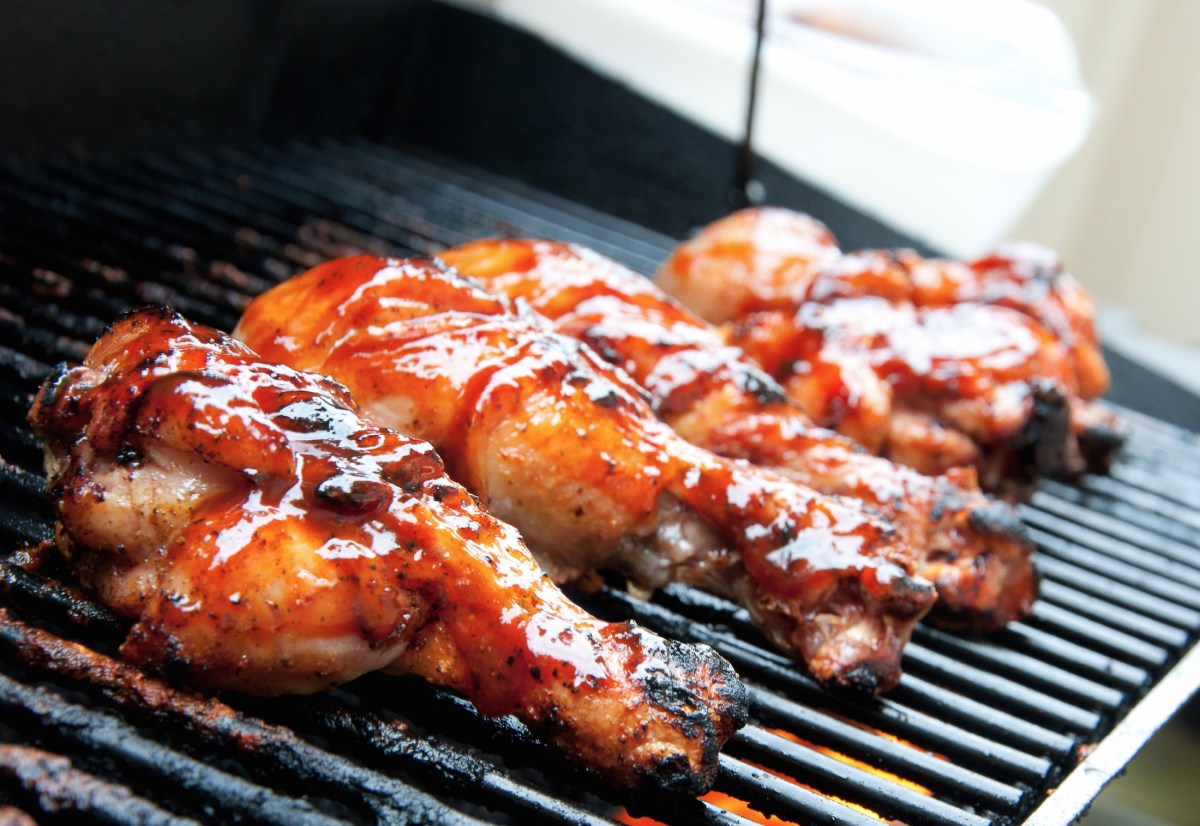Summer’s sizzling heat beckons, and the aroma of grilling meat fills the air. But for those with nut allergies, enjoying classic BBQ sauces can be a challenge. Fear not! This guide dives into the vibrant world of nut-free BBQ sauces, revealing delicious recipes, grilling techniques, and storage tips to ensure your grilling season is both safe and flavorful. Prepare to embark on a culinary adventure where bold flavors reign supreme, free from the constraints of nuts.
We’ll explore five fantastic nut-free BBQ sauce recipes, each with its unique personality—from smoky chipotle to sweet and tangy. Discover the secrets to achieving perfect caramelization and preventing burning, mastering the art of basting, and ensuring your homemade sauces remain fresh and delicious for weeks. Get ready to elevate your grilling game with these allergy-friendly masterpieces.
Variations on Nut-Free BBQ Sauce Flavors
The world of barbecue sauce is vast and exciting, offering a spectrum of flavor profiles to tantalize the taste buds. While nuts are a common ingredient in many recipes, delicious and complex nut-free options abound, catering to those with allergies or preferences. This section explores three distinct nut-free BBQ sauce flavor profiles, highlighting the key ingredients that create their unique character.
Each flavor profile relies on a careful balance of sweet, sour, salty, and spicy elements, along with the addition of smoky notes or other unique aromatics. The interplay of these elements, coupled with the right consistency, determines the overall quality and appeal of the sauce.
Smoky Chipotle BBQ Sauce
This sauce delivers a deep, smoky heat with a hint of sweetness. The smoky flavor is achieved through the use of smoked paprika and chipotle peppers, while the sweetness is provided by molasses or brown sugar. The chipotle peppers contribute a complex smoky heat that builds gradually. The balance between sweet and smoky heat is crucial for this profile.
The specific ingredients contribute to the sauce’s overall character in several ways:
- Smoked Paprika: Provides a deep, smoky flavor without the intense heat of chipotle peppers. Imagine the rich, earthy aroma of woodsmoke clinging to the paprika flakes.
- Chipotle Peppers in Adobo Sauce: Offer a complex smoky heat and a touch of sweetness from the adobo sauce. The color is a deep, dark reddish-brown, hinting at the intense flavor within.
- Molasses or Brown Sugar: Contributes a rich, deep sweetness that balances the smoky heat of the chipotle peppers. The molasses provides a slightly bitter note that adds complexity.
- Apple Cider Vinegar: Adds a tangy brightness that cuts through the richness of the molasses and the heat of the chipotle peppers. Its sharp, fruity notes create a pleasant contrast.
- Garlic and Onion Powder: Provides a savory base that enhances the other flavors without overpowering them. Their aromas combine to create a pungent and inviting scent.
Sweet and Tangy BBQ Sauce
This profile prioritizes a balance of sweet and tart flavors, creating a bright and refreshing sauce. The sweetness is often derived from brown sugar or honey, while the tang comes from apple cider vinegar or lemon juice. A touch of mustard adds a subtle sharpness.
The combination of ingredients creates a vibrant and well-rounded flavor profile:
- Brown Sugar or Honey: Provides a rich sweetness that forms the foundation of the sauce. The honey offers a floral complexity that brown sugar lacks.
- Apple Cider Vinegar or Lemon Juice: Adds a bright, acidic tang that balances the sweetness and prevents the sauce from being cloying. The lemon juice lends a more citrusy brightness.
- Dijon Mustard: Contributes a subtle sharpness and a creamy texture. Its tangy notes enhance the overall flavor profile.
- Tomato Paste: Adds body and umami depth to the sauce, enriching its overall texture and taste. The rich, deep red color of the paste adds visual appeal.
- Worcestershire Sauce: (Ensure it’s nut-free!) Adds a complex umami flavor and a subtle savory depth, enhancing the overall balance of the sauce.
Spicy Bourbon BBQ Sauce
This bolder option combines the sweetness of bourbon with a fiery kick. Bourbon provides a warm, caramel-like sweetness and a subtle oaky note, while cayenne pepper or other chili flakes add a spicy punch. A touch of brown sugar further enhances the sweetness.
The interplay of ingredients creates a robust and flavorful experience:
- Bourbon Whiskey: Adds a warm, caramel-like sweetness and a subtle oaky note. The aroma of the bourbon is rich and complex, hinting at its underlying flavors.
- Cayenne Pepper or Chili Flakes: Provides a fiery kick that complements the sweetness of the bourbon. The intensity of the heat can be adjusted based on preference.
- Brown Sugar: Enhances the sweetness and adds depth to the overall flavor profile. Its deep brown color adds visual richness to the sauce.
- Tomato Ketchup: Provides a base for the sauce, adding body and a familiar tomato flavor. The bright red color of the ketchup is visually appealing.
- Garlic and Onion Powder: Provides a savory foundation that complements the other flavors. Their combined aroma is pungent and enticing.
Grilling Techniques with Nut-Free BBQ Sauces

Mastering the art of grilling with nut-free BBQ sauces involves understanding the interplay between heat, meat type, and sauce application. The goal is to achieve a perfectly caramelized exterior with a juicy, flavorful interior, all while avoiding the dreaded burnt sauce. Different meats require varying approaches, and the timing of sauce application is crucial for optimal results.
The optimal grilling technique depends heavily on the type of meat and its thickness. Thicker cuts, like brisket or pork shoulder, benefit from a low-and-slow approach, allowing for deep penetration of flavor and tenderness. Leaner meats, such as chicken breasts or fish fillets, require higher heat and shorter cooking times to prevent drying out. Using a nut-free BBQ sauce enhances the grilling experience by adding a layer of rich, complex flavor without the risk of nut allergies.
Applying Nut-Free BBQ Sauce to Different Meats
The application of nut-free BBQ sauce is a delicate dance between enhancing flavor and preventing burning. Leaner meats, like chicken and fish, should receive a light basting only during the final few minutes of cooking to prevent the sauce from burning before the meat is cooked through. Thicker cuts, however, can benefit from multiple applications throughout the cooking process, allowing the sugars in the sauce to caramelize and create a delicious glaze. For example, a brisket might receive a light coating every hour during a long, slow cook, while a chicken breast might only receive a final coat during the last five minutes.
Optimal Timing for BBQ Sauce Application
The best time to apply nut-free BBQ sauce is during the latter stages of grilling. This prevents the sugar in the sauce from burning before the meat is cooked through. For thicker cuts of meat, multiple applications are ideal, spaced out throughout the cooking process. For thinner cuts, a single application towards the end is sufficient. The high sugar content in most BBQ sauces makes them prone to burning quickly at high temperatures.
Step-by-Step Guide to Basting Meat with BBQ Sauce
- Prepare the Sauce: Ensure your nut-free BBQ sauce is at room temperature. This allows for more even application and prevents the sauce from cooling the meat too quickly.
- Preheat the Grill: A properly preheated grill ensures even cooking and prevents sticking. The ideal temperature will depend on the type of meat.
- Season the Meat: Season your meat generously with salt, pepper, and any other desired spices before applying the sauce. This adds another layer of flavor.
- Initial Cooking: Cook the meat according to its type and thickness, without applying sauce initially. This allows for proper searing and development of flavor.
- First Basting: Once the meat has cooked for a significant portion of its total cooking time, begin basting with the nut-free BBQ sauce. Use a brush to apply a thin, even coat, avoiding excessive pooling.
- Continue Cooking and Basting: Continue cooking, basting periodically, ensuring the sauce doesn’t burn. For thicker cuts, repeat the basting process every 30-60 minutes. For thinner cuts, a final basting in the last few minutes is sufficient.
- Check for Doneness: Use a meat thermometer to check for doneness, ensuring the internal temperature reaches the safe minimum for the type of meat.
- Rest and Serve: Allow the meat to rest for a few minutes after cooking to allow the juices to redistribute before serving.
This grilling season, let the tantalizing scents of nut-free BBQ sauces waft through your backyard. Armed with these recipes, techniques, and storage tips, you can confidently create mouthwatering BBQ masterpieces that everyone can enjoy, regardless of dietary restrictions. So fire up the grill, gather your friends and family, and prepare for a summer of unforgettable flavor, all while keeping nut allergies firmly in mind. The perfect BBQ awaits!
FAQ Explained
Can I use store-bought nut-free BBQ sauce?
Absolutely! Just always double-check the ingredient label to ensure it’s truly nut-free and free of cross-contamination.
How long can I store homemade nut-free BBQ sauce in the refrigerator?
Properly stored in an airtight container, homemade nut-free BBQ sauce typically lasts for 1-2 weeks in the refrigerator.
Can I freeze nut-free BBQ sauce?
Yes, freezing is a great way to extend the shelf life of your homemade sauce. Freeze it in ice cube trays or small containers for easy portioning.
What are some good substitutes for sugar in nut-free BBQ sauce?
Honey, maple syrup, or agave nectar can be used as substitutes for sugar, adjusting the amount to your preference.
Are all commercially available BBQ sauces nut-free?
No. Many commercially available BBQ sauces contain nuts or are produced in facilities that also process nuts, so always carefully check labels.


